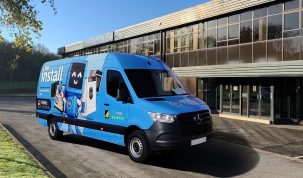
Some ideas are ahead of their time. Eight years ago, Bush launched an internet TV, allowing viewers to access the web from the comfort of their couch. But the system was slow (most homes only had dial-up internet connections) and clunky. Fast forward eight years, and the situation has changed beyond recognition. Government statistics show that, in 2008, more than 65% of all homes in Great Britain had internet access, with more than half of all homes (56%) having broadband connections. What is more, broadband speeds are increasing all the time.
Broadband-enabled products
The move from analogue technology to digital means that consumer electronics devices, such as televisions, Blu-ray players and PVRs, speak the same language as computers. Little wonder then, that we are seeing the convergence of CE products, broadband and the web. A snapshot sample of convergence products on the market includes LG’s 2009 Blu-ray Disc products, which allow users to access YouTube content on their TV screen. LG also plans to introduce a video-on-demand service that will give consumers access to video content from the web. The service will even analyse the speed of the user’s broadband connection and adjust picture quality accordingly, so that the video plays smoothly on the TV screen.
Loewe offers two TV ranges with home broadband connectivity – the Connect and Individual (Compose 40/46/52, and Selection 40/46). The Connect, launched in late 2007, allows users to access photo, film and music files saved on the home PC network via wireless broadband or an Ethernet cable. The Individual Compose 52 is a 52in TV with an integrated NMP 2100 network Mediaplayer. Later this year, Loewe will launch the Individual Mediacenter, an intelligent media hub that also functions as an audio server. Samsung offers Internet@TV on its top-of-the range flat display televisions, allowing users to access a range of internet content on their television, including YouTube, Flickr, Yahoo News, weather and finance. Further content will be added to the Internet@TV service throughout the year. Samsung’s new range of Blu-ray players includes wireless capability that allows consumers to connect their home network to the online BD Live service. The high end models will also allow customers to wirelessly stream media content from their PC or laptop.
Sony’s broadband-enabled range includes a number of Bravia televisions (such as the V5500, W5500, WE5, E5500, Z4500 and X4500 series), the NAS-E35HD Giga Juke audio system and several Vaio home entertainment systems, the TP3, LN, LV and RT series. The Bravia sets also include an AppliCast internet widget that enables internet content to be displayed on-screen.
Panasonic has launched its Viera Cast service, available on its Z1 Series, V10 Series, and G15 series plasma TVs, and LCD V10 and G15 Series. It’s also available on some Blu-ray products. Viera Cast uses a home broadband connection to bring content from selected websites sites such as YouTube, Picasa, Eurosport and Bloomberg news, offering a mix of video and images.
Graham North, Humax UK’s commercial director, says: “Broadband services will continue to have a big influence on digital TV in 2009. On-demand services such as BBC iPlayer will become increasingly available via the set top box, paving the way for increased content delivered via the internet, as well as other internet applications further down the line. The set-top box will really become the hub of the digital home.”
Consumer expectations
North also believes that: “The way we watch television and consume media is about to be completely revolutionised. The connected home has been a long time coming but is now finally imminent and will see the internet unite television, communications, content creation, music, gaming and digital media within the home. By blending digital media the UK broadcast industry can take home entertainment to a whole new level – like so many technological advances, this will begin with a small group of early adopters before being embraced by the mass market.”
Others also think that convergence will be a mass market phenomenon and not just something that appeals to ‘techies.’ “This is without doubt a mass market proposition, as with most advances in technology, early adopters will take up the new services to begin with, but as more and more internet capable CE devices enter the market this will open out to a much larger number of consumers”, says Samsung product manager Darren Petersen, noting that: “the Internet is just a new way of broadcasting content, the same as terrestrial TV, satellite, cable, radio and so on.” Petersen adds that the popularity of videos on websites such as YouTube has grown dramatically over the last ten years: “There is a plethora of content on the internet waiting to be released from traditional viewing on laptops and desk top PCs to a more user friendly experience – whether that be relaxing on a sofa watching a 50in plasma or your mobile phone,” he says.
Daniel Aziz, marketing manager, LG Electronics digital media, says: “We think consumers want to be able to access the different media that is available, but they don’t want it to be difficult or complicated to use the product. If we offer consumers a simple proposition, then convergence will be a mass market offering.” Kevin Kelly, managing director of Loewe UK, says: “Unsurprisingly, younger, more tech-savvy consumers have been considered as the early adopters, but we’ve found that a variety of demographics are understanding the benefits of our home networking products – from watching movies, to playing videogames, listening to music or viewing a photo slideshow – it is now possible to cater for all of these needs using a single TV connected to the home PC network.” Dipesh Sanghrajka, Sony’s Vaio product manager, Sony UK, says that convergence is: “Moving towards a mass market proposition due to services like BBC iPlayer.”
Connectivity issues
One thing everyone is agreed on is that if consumer electronics devices and the internet are going to mix, connecting products to a home broadband service has to be as simple as possible. So how simple is it? “Connecting one of our TVs to the internet is very simple and can be connected via an Ethernet cable or an optional wireless dongle [plug-in connector],” says Simon Storey, a Samsung product manager. Sony’s Sanghrajka, adds that the connection process is: “Very easy, as connection is via Wi-Fi, and the product will pick up the connections automatically.” LG’s Aziz says, as with Samsung’s broadband-enabled products, consumers can just plug in an Ethernet cable: “As long as your router doesn’t require you to register a new device on the home network, they will connect.” LG plans to launch a wireless connection system at the end of the year.
At the heart of the home
Companies are divided over whether consumers want a PC-type device in their living room. Sony’s Sanghrajka, thinks they do: “Absolutely. There are some products specially designed for the living room such as a TP3. This brings together sleek design and all the benefits discussed above, plus Blu-ray or DVD and the ability to record programs too.” But Samsung’s Petersen thinks that: “Generally speaking, no. Most consumers want to relax when in the lounge. Our wireless DLNA-enabled (the Digital Living Network Alliance standard) TVs allow users to stream media files (movie, music and images) from anywhere in the house, eliminating the need for a laptop or PC in the lounge. This is also the case with the PC connected functionality on our top-end Blu-ray players.” Loewe’s Kelly adds that: “Consumers are increasingly using their homes in different ways, with studies and computer rooms taking a backseat to the living room as the hub of the home network. I think televisions will remain about en
tertainment and at the heart of the living room – after all, the TV is one of the few devices that young and old can operate successfully and I hope this doesn’t change.”
Issues to resolve
It seems then, that technology and ease of use are no longer the barriers to convergence, so what is holding back the market? LG’s Aziz says: “There’s no service over one platform, so it’s difficult to adapt all of these to a platform that’s easy to use. Everyone is focusing on the user experience and making products as simple to operate as possible.” Samsung’s Storey thinks: “A lack of awareness: many consumers are still surprised when they realise they have Freeview built into their new TV, but this has now been standard for a few years. Many consumers don’t seem to realise exactly what their new TV is capable of and how easily they can turn it into a fully functioning media centre.” Loewe’s Kelly notes that consumer knowledge of media centre products is improving but still limited, adding that it is important that retailers educate their customers on the opportunities presented by this type of technology. Awareness and understanding of the concept are the two barriers cited by Sony’s Sanghrajka.
Looking at how this market might develop, Samsung’s Petersen says: “I’m sure we will see iPlayer technology on TVs soon. This type of technology will most definitely appear on next generation TVs – it is just a question of when.” LG’s Aziz sees online video-on-demand services becoming more popular, as well as internet TV and AV products becoming integrated. “Content from them will be sent wirelessly around the home – that’s the next step,” he says. Sony’s Sanghrajka, says: “The market will develop as people begin to understand all the benefits that these products can deliver, that is, there is no need to have so many separate devices (and remotes controls) in the living room. Demand will also grow as people discover services like BBC iPlayer on the big screen rather than a PC.”











